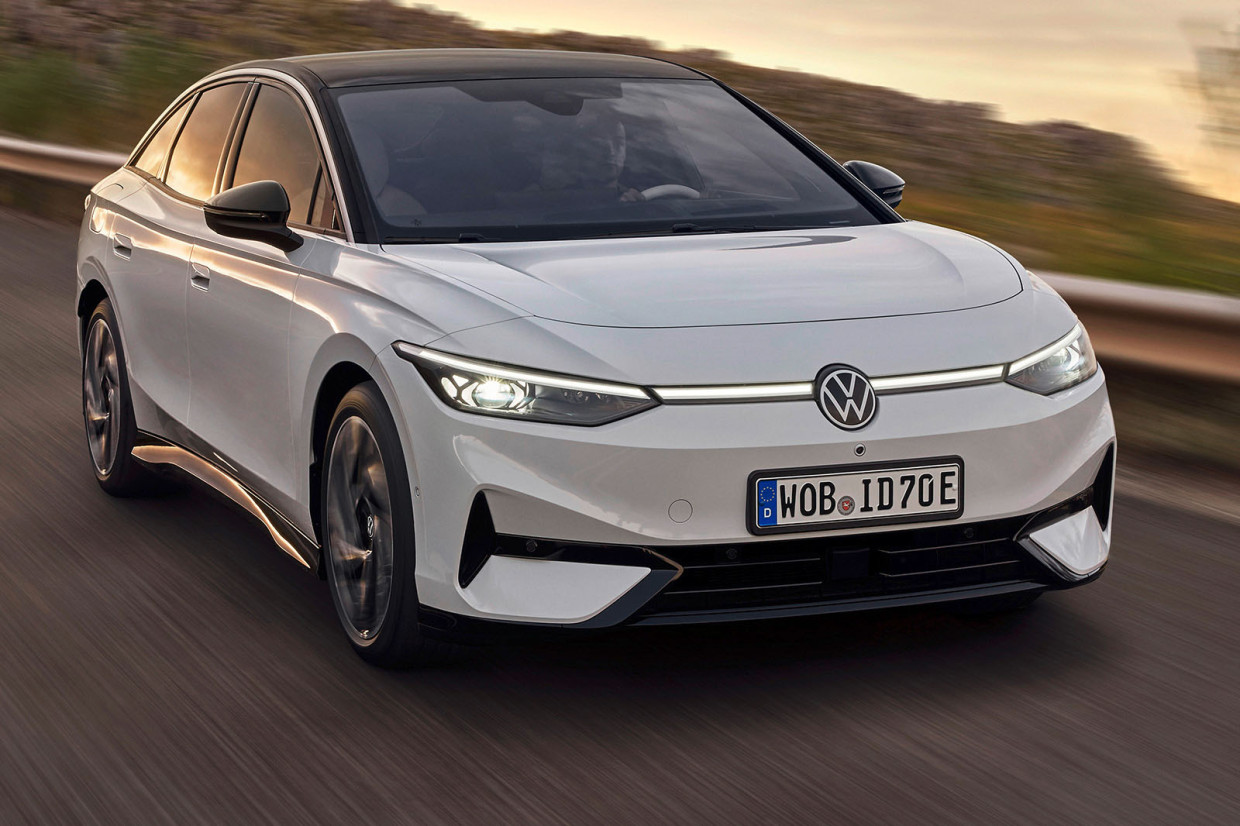
The new Volkswagen ID 7 is a new aerodynamically honed electric saloon designed to take on the likes of the Tesla Model 3 and Hyundai Ioniq 6 with raft of new technology and a range of up to 435 miles.
The newest machine from the German giant joins the ID 3 hatch, ID 4 SUV, ID 5 coupe-SUV and ID Buzz MPV in its ever-expanding line-up of bespoke electric models using the VW Group’s MEB platform. Described as Volkswagen’s new ‘flagship’ EV, it is intended as a long-distance touring saloon, and has been developed with a focus on maximising range and interior comfort.
The latest EV news in your inbox: get out FREE newsletter
The ID 7 was previewed by the Aero B concept car, and that name hints at the design focus. It is 4961mm long, with an extended wheelbase of 2966mm to maximise interior range. The streamlined design of the machine, including a coupe-style C-pillar and sloping rear end, helps it achieve a drag coefficient of 0.23.

The machine will launch with two versions: Pro and Pro S, both of which will use different battery sizes. Pro models will use a 77kWh net (82kWh gross) battery, giving a range of up to 615km. That battery can be charged at speeds of up to 170kW, which is a notable step up from current Volkswagen ID models.

The top-spec Pro S model features the biggest battery yet seen on an electric VW: an 86kWh net (91kWh gross) unit that allows for that headline 700km range. The new battery can be charged at speeds up to 200kW, and also features a preconditioning function that starts automatically when heading to a charging station that’s plugged into the car’s sat nav.

As well as that new battery, the ID 7 also gains Volkswagen’s newest electric drive system. The unit combines a 210kW drive motor along with a two-stage, one-speed gearbox and the inverter, and VW claims it offers an improved thermal load capacity.

Full technical specifications and performance figures for the ID 7 have yet to be disclosed, and we do know the initial rear-drive single-motor versions will be followed by more potential twin-motor all-wheel-drive models – with a range-topped set to carry the GTX performance badge.
Volkswagen says that interior has been designed to offer maximum internal space and passenger comfort. That said, the firm has yet to give interior dimensions or tell us how much space there is in the boot, so we’ll have to wait to really judge that.

The dashboard has been completely redesigned from other ID models, with a horizontal layout designed to emphasis the width of the car. But the most notable change is the driver cockpit area.

The traditional driver info display has been shrunk down, with many of the functions have been shifted onto an ‘augmented reality’ head-up display that, in a Volkswagen first, is standard on all ID 7 models. While the small traditional display shows key functions such as speed and any warnings, the head-up display includes other information such directions, road sign information, speed limited and so on.

According to Volkswagen, information such as your current speed and the road limit are projected onto a range about 3.5 metres in front of the vehicle, while navigation directions and the like are projected around 10 metres into the distance.
With the drive info display shrunk, the main feature on the dashboard is the 15in touchscreen, which features the latest version of VW’s infotainment system that offers a restructured interface. That includes two permanently visible touch bars to access key functions.

Below the screen, the controversial touch sliders from other ID models remain, although – praise be! – these are now illuminated, so you’ll actually be able to spot them when you’re driving in the dark. The system also gains the latest version of VW’s voice assistant function, while a 14-speaker Harman Kardon audio system is offered as an option.
The front seats are offered with a new climate control system, which can allow for up to 14 electrical adjustments. Oh, and there’s a seat massage function too, for those days you’re doing a lot of driving to try and push that range.
A panoramic sunroof is an optional extra, and features a polymer-dispersed liquid crystal (PDLC) layer that means it can be made opaque or transparent.

There are also a load of smart driving systems, including Volkswagen’s Park Assist Pro – that’s the one where you can ‘save’ your reversing moves which the car can then repeat for you – and a Travel Assist cruise control function that uses ‘swarm data’ from other VW models to automatically adjust the speed based on what vehicles around you are doing. It will also eventually offer assisted lane changing on multi-lane motorways.
The ID 7 is due to go into production at Volkswagen’s Emden plant in Germany later this year, with European deliveries starting in the autumn. It will also launch in China this year, before going on sale in North America in 2024. There is no word yet on UK pricing or specifications.

READ MORE
Subscribe to the Move Electric newsletter
e-CARS
What is a heat pump and how do they benefit electric cars?
Bold new Volkswagen ID 2all previews sub-£22,000 electric car
e-BIKES
Ten electric bikes we're excited for in 2023
Nine ways to keep your e-bike safe
E-bike theft: how common is it and what can you do to protect your e-bike?
Haibike AllMtn CF 6 e-bike review
e-MOTORBIKES
10 electric motorbike start-ups you should watch out for
Energica e-motorbike to take on all-comers in US racing series
Ducati: How the Italian motorbike brand is gearing up for the electric era
e-SCOOTERS
Planned laws to legalise private e-scooters face delay
Leading e-scooter firms team up on best-practice guide for cities
Ambiguity over e-scooter legality causing ‘confusion’, says police chief
e-WORLD
Solar panels: 8 ways the sun can power your electric life
First ride: Lunaz Upcycled Electric Vehicle bin lorry
